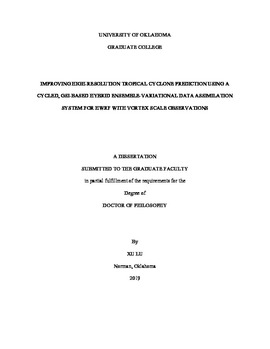| dc.contributor.advisor | Wang, Xuguang | |
| dc.contributor.author | Lu, Xu | |
| dc.date.accessioned | 2019-11-27T14:40:21Z | |
| dc.date.available | 2019-11-27T14:40:21Z | |
| dc.date.issued | 2019-12-13 | |
| dc.identifier.uri | https://hdl.handle.net/11244/322825 | |
| dc.description.abstract | A Gridpoint Statistical Interpolation analysis system (GSI)-based, continuously cycled, dual-resolution hybrid ensemble-variational (EnVar) data assimilation (DA) system is developed for the Hurricane Weather Research and Forecasting (HWRF) Model. The newly developed DA system is then used in this dissertation to address a few scientific and technical challenges in assimilating the vortex-scale observations to improve the numerical prediction of TCs.
In the dissertation, the newly developed DA system is described first. Then, the next part addresses how various data assimilation configurations impact the vortex scale observation assimilation and the subsequent prediction using the DA system. It is found that (1) dual-resolution EnVar DA improves the analyzed storm structure and short-term maximum wind speed (Vmax) and minimum sea level pressure (MSLP) forecasts compared to coarser, single-resolution EnVar DA, but track and radius of maximum wind (RMW) forecasts do not improve. (2) Additionally, applying vortex relocation (VR) and vortex modification (VM) on the control background before DA improves the analyzed storm, overall track, RMW, MSLP, and Vmax forecasts. Further applying VR on the ensemble background improves the analyzed storm and forecast biases for MSLP and Vmax. (3) Also, using four-dimensional (4D) EnVar to assimilate tail Doppler radar (TDR) data improves the analyzed storm and short-term MSLP and Vmax forecasts compared to three-dimensional (3D) EnVar although 4DEnVar slightly degrades the track forecast. (4) Finally, a diagnostic on why advanced DA can improve the TC intensity forecast for Edouard (2014) is provided.
In the third part, using the further upgraded DA system, the deficiency of the numerical model physics was discussed. Although the DA produces realistic 3D analyses to initialize the model, persistent Vmax spin-down is found during the rapid intensification of hurricane Patricia (2015). Diagnostics reveal that the spin-down issue is likely attributed to the deficient HWRF model physics which are unable to maintain the realistic 3D structures from the DA analysis. The horizontal diffusion is too strong to maintain the realistically observed vertical oscillation of radial wind near the eyewall region. The vertical diffusion profile cannot produce a sufficiently strong secondary circulation connecting the realistically elevated upper-level outflow produced in the DA analysis. Further investigations with different model physics parameterizations demonstrate that spin-down can be alleviated by modifying model physics. In particular, a modified turbulent mixing parameterization scheme together with a reduced horizontal diffusion is found to significantly alleviate the spin-down issue and to improve the intensity forecast. Additional experiments show that the peak simulated intensity and rapid intensification (RI) rate can be further improved by increasing the model resolution. But the model resolution is not as important as model physics in the spin-down alleviation.
The last part of the dissertation explores the relative impact of various vortex scale observations on the analysis and prediction of hurricane Patricia (2015). In comparing the impacts of assimilating each dataset individually, results suggest that: (1) The assimilation of 3D observations produces better TC structure analysis than the assimilation of two-dimensional (2D) observations; (2) The analysis from assimilating observations collected from platforms that only sample momentum fields produces a less improved forecast with either short-lived impacts or slower intensity spin-up as compared to the forecast produced after assimilating observations collected from platforms that sample both momentum and thermal fields; (3) The structure forecast tends to benefit more from the assimilation of inner-core observations than the corresponding intensity forecast, which implies better verification metrics are needed for future TC forecast evaluation. | en_US |
| dc.language | en_US | en_US |
| dc.rights | Attribution-NonCommercial-NoDerivatives 4.0 International | * |
| dc.rights.uri | https://creativecommons.org/licenses/by-nc-nd/4.0/ | * |
| dc.subject | Data Assimilation | en_US |
| dc.subject | Hurricane | en_US |
| dc.subject | Vortex Scale Observations | en_US |
| dc.title | Improving High-Resolution Tropical Cyclone Prediction using a Cycled, GSI-Based Hybrid Ensemble-Variational Data Assimilation System for HWRF with Vortex Scale Observations | en_US |
| dc.contributor.committeeMember | Vedula, Prakash | |
| dc.contributor.committeeMember | Biggerstaff, Michael | |
| dc.contributor.committeeMember | Sakaeda, Naoko | |
| dc.contributor.committeeMember | Wicker, Louis | |
| dc.date.manuscript | 2019-11-13 | |
| dc.thesis.degree | Ph.D. | en_US |
| ou.group | College of Atmospheric and Geographic Sciences::School of Meteorology | en_US |
| shareok.orcid | 0000-0001-8786-2831 | en_US |

